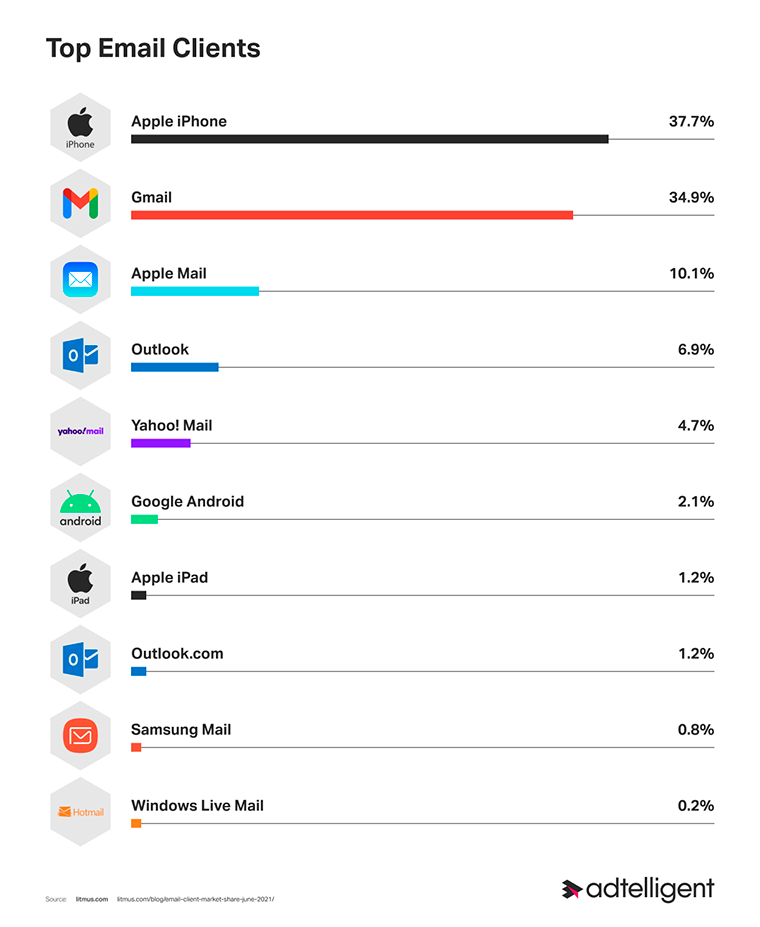According to numerous research, the distress over personal data usage keeps growing with each year. As a result, people want to be in control over their personal information as much as possible. And the various digital industries must comply with this wish.
In this light, Apple unveiling of their new privacy policy including changes concerning Identifier for Advertisers (IDFA) on mobile devices and Mail Privacy Protection at the Worldwide Developers Conference 2021 came as no surprise, yet managed to puzzle the digital marketing industry. The company announced that Apple Mail will no longer provide detailed insights into the user data such as open rate and open location and will restrict the use of IDFA, which means that advertisers now need to find ways to work with these new rules.
Marketers are particularly concerned by these changes; according to the polls, 41% of publishers expressed worry about the impact on email hash identifiers, and the same number of respondents are concerned about their email monetization abilities. In the light of the future cookie depreciation, many industry’s players have put their trust into email-based identity solutions (63%). Under new Apple’s privacy rules, this trust can eventually be misplaced as email identifiers might prove to be less valuable under the circumstances.
Considering that iPhone takes a big chunk of the overall email client share at 37.7%, after the update release, marketers will lose access to a lot of relevant analytical data and will struggle to deliver effective email marketing campaigns. Following these changes, advertisers must rethink their marketing strategies and adjust to the new changes proposed by Apple.

What is MPP?
MPP stands for Mail Privacy Protection feature, which Apple announced for iOS 15, iPadOS 15, macOS Monterey, and watchOS 8. It will prevent tracking pixels leverage within letters by automatically preloading all emails using proxy servers. Implementation of MPP is done by simply connecting the user’s email account to the Apple Mail app, no additional steps are needed.
Сonsumers will need to go to their settings to activate the MPP, but Apple will also encourage users to turn on this new feature during their first email activity after the rollout of the latest OS update.
MPP will mainly focus on two capabilities: hiding users ’ IP addresses and blocking all remote content. The first setting provides a random IP address upon the opening of the Apple Mail app to hide the real ones from the sender. This feature prevents advertisers from getting email-related activity data and IP-based location intel. Block All Remote Content setting automatically caches all images throughout emails, loading the open tracking pixel that intervenes with the depiction of user’s engagement with the content and prevents automatic loading of the pictures in the emails.
Why is this change important?
Apple policy change signals an upcoming advertiser-consumer relationship transformation. Consumers strive for more relevant, personalized content, and in order to deliver that, advertisers should be able to gather some useful intel to craft relevant ads and build mutually beneficial relationships with a customer.
After the above-mentioned changes, the ability to deliver such experiences is shuttered due to the absence of important metrics. There is a high possibility of disrupting these relationships when email boxes would be flooded with standardized email content leading to customer dissatisfaction, which in turn would prevent brands from building an engaging connection with their client base.
The move towards an increase in privacy is inevitable and is celebrated for creating a more safe and transparent advertising environment. That’s why in the wake of constant changes, brands and businesses must be ready to adapt to the new circumstances and adhere to new rules. The difficult part is to find a balance and manage to satisfy advertising needs and demands while simultaneously searching for ways to deliver high-quality experiences to customers.
There is also a problem in the uncertainty about the ways to gather the required information to maintain the proper quality and efficiency of email campaigns for marketers.
What is IDFA?

An identifier for Advertisers or IDFA is a type of identifier for mobile devices that is aimed at measuring the effectiveness of the marketing campaigns and advertising across mobile users.
During Worldwide Developers Conference (WWDC) last year Apple announced that users could opt to block sharing their IDFA at the App level. Now Apple сustomers would see an alert informing them of the options to share their IDFA with marketeers or to drop out of it completely. The rollout of this update has been postponed recently, so advertisers have more time to prepare.
The unveiling of such IDFA restrictions threatens to complicate numerous mobile-related advertising processes including targeting and attribution, as well as data aggregation. The company has discreetly employed Limited Ad Tracking (LAT) for years, usually hidden within settings, but amid new privacy regulations, Apple is shifting its privacy policies towards more restrictions and regulations, aiming at providing clear-cut choices for users. The IFDA change fits this narrative, especially considering the earlier move away from third-party cookie use.
How it affects marketing?
Besides the obvious consequences on data mining and management, the above-mentioned change is significant in terms of ad targeting and measurement.
Ad targeting will be affected by a reduction in the targetable audiences due to the high percentage of people who opt-out of sharing their IDFA with advertisers. Thus, many types of targeting will simply not work across Apple mobile devices. Various programmatic platforms will suffer the biggest blow as they usually do not have alternative identifiers unlike such giants as Google or Facebook that have users’ emails and phone numbers at their disposal.
Ads measurement will exhibit less accurate data concerning potential fraud. Mobile Measurement Partners (MMPs) that spot fraudulent activities revolve around IDFA identifiers. Apple provided a replacement API (SKAdNetwork) that is supposed to bring back conversion intel, however, the accuracy of the measurements and performances will be in question.
This change will also impact users, as they will no longer receive relevant advertising and will see ads that weren’t properly personalized.
How to be prepared?
Considering these changes, marketers of all levels should embrace new ways of getting along with the transformations of the digital marketing segment and be ready to implement different strategies in order to reach the required goals.
Mail Privacy Protection
- Evaluate email preferences of the client base
This step includes figuring out how many customers are currently using Apple Mail to understand which segment of your audience might need adjusting soon. Some email software can provide such evaluation, just make sure it is anonymous and comply with the existing privacy rules.
- Stay transparent with your customers
Consumer trust is steadily becoming one of the most valued currencies in the advertising market. Amid all data usage restrictions and internet users’ strive for privacy, building and maintaining trustworthy relationships between brands and client base is a must. Being transparent and clear about data management and gathering, informing customers of the ways their information is leveraged is one of the ways to do it. Being upfront about email tracking activities, explaining how the brand is adhering to new privacy rules, reassuring the respect of customers’ privacy and wishes connected with it – all of these things can help to build fruitful relationships with customers and evoke loyalty and engagement.
- Focus on deliverability
Getting clear permission for one’s clients while adhering to privacy laws is a must under current circumstances. So email sign-up and permissions practices can be of great help. Creating a transparent system of preferences and giving customers a choice to decide which content they want to see is a very good strategy to build open and fruitful relationships with an audience.
- Develop new personalization and performance measurement strategies
A recent study shows that 52% of users note the connection between personalized content and their level of satisfaction with a brand. This is yet another proof that along with the respect for users’ privacy, they expect a certain level of personalization, so the need for a proper balance between them is urgent. In order to achieve this goal, we can recommend the following measures:
- Do not neglect deeper engagement metrics, go further than just open rates. Pay attention to conversion and click-through rates, forwards, and prints.
- Employ artificial intelligence (AI) tools to drive up the personalization levels, feeding AI with as much available data as possible.
- Set out email campaign goals and measure your performance along the way of transitioning to the new strategies and trying out novel approaches.
- Determine overreliance on the open rate metrics
The release of the MPP will over-inflate the open rate numbers, especially if the big chunk of the customer base uses Apple devices. So instead, determine where you over-rely on open rates, redefine these dependencies using deliverability factor or inbox placement.
- Start testing
One of the most important practical steps to take within the preparation for the MPP process is to A/B test all email marketing ideas. This testing includes sending 2 versions of one email with slight changes done to one, to see how well both options perform. It is a good way to provide basic insights into the audience reactions and help to build effective email marketing strategies in the future.
IDFA
The preparation process for the upcoming IDFA restrictions requires the following measures:
- SKAdNetwork implementation and calibration
SKAdNetwork is the alternative API proposed by Apple, so it is a good idea to get acquainted with the system and test it to achieve better results, even under the uncertainty of its capabilities.
- Employ the power of persuasion and creativity
You can try and persuade users to agree to share IDFA by using a creative approach and visuals. Engaging stories and a clear explanation of possible benefits can be very effective. Advertisers can A/B test various models before going all in and crafting the final message behind the need for data collection and trusty relationships with a brand.
- SKAdNetwork’s Conversion Models
SKAdNetwork is the sole source of any post-install conversion data, so using this intel well is crucial in evaluating whether the install is valuable. Organizing this data and post-install activities can help to determine which advertising channel is effective under the recent Apple updates
- Think about IDFA alternatives
Internal IDs or the IDFV (Identifier for Vendors) can be used as a replacement for the restricted IDFA’s. IDFV is especially useful, as it is assigned to numerous app produced by one developer and is shared between all these apps on one device. It can be a great tool for cross-apps promotions and identifying users across numerous devices. Adtelligent added IDFV macros to the Platform recently and you can learn more in our product updates release.
Key Takeaways
With the variety of latest privacy updates and rules, there is a clear shift towards privacy protection and data gathering restrictions in the advertising ecosystem. All parties involved must be prepared to adjust and adhere. These processes are quite new to the industry, and, considering the intricacy of the world of digital advertising, should not negatively affect advertisers or publishers, but present a proper alternative to the existing practices. However, it is a long and complex process that might take a while to become a balanced one, so for now marketers should be prepared for changes and find creative and innovative ways to achieve their goals while complying with the industry’s upcoming changes.